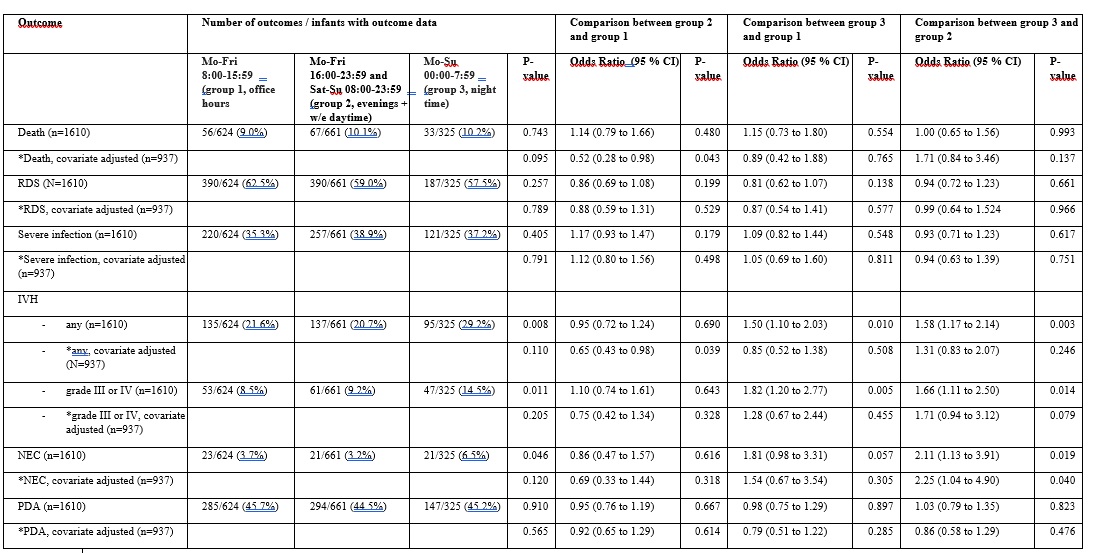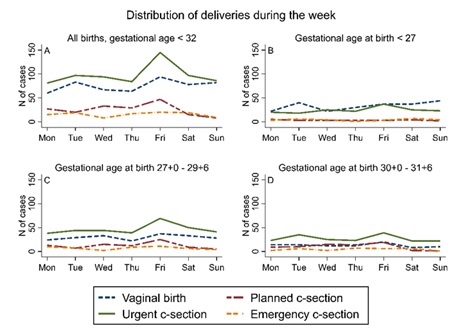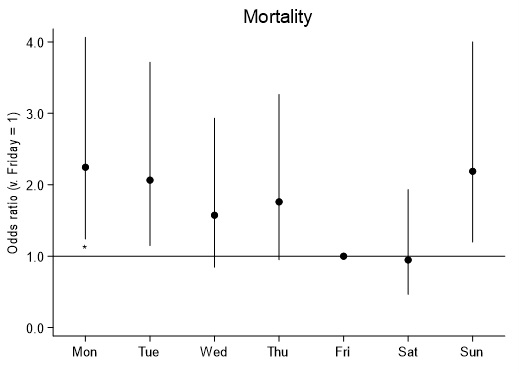Neonatal-Perinatal Health Care Delivery: Practices and Procedures
Neonatal-Perinatal Health Care Delivery 4: Epi/HSR Utilization, Cost, Outcomes
776 - Time of delivery contributes to mortality and morbidity in preterm infants
Publication Number: 776.248

Tiina M. Teivaanmäki, yes (she/her/hers)
Neonatologist
Helsinki University Hospital
Hyvinkää, Uusimaa, Finland
Presenting Author(s)
Background:
Preterm infants are prone to multiple problems that are critically affected by the events of the “golden hour”, i.e. the first 60 minutes of life. The timing of the golden hour, that is, the time of delivery, may also play a role. Some studies have for example shown worse outcomes for infants born at nighttime, but the evidence is controversial.
Objective:
Our objective was to study the time of birth of preterm infants and to compare the risks of mortality and morbidity between infants born at different time periods during the day and the week. We hypothesized that deliveries peak towards the end of the week and that the outcomes are worse for infants born at nighttime.
Design/Methods:
This study was conducted as part of the Big Data–Tiny Infants research project in the neonatal intensive care unit (NICU), Helsinki University Children’s Hospital, Finland. We explored the time and mode of delivery by day and by hour of infants born with gestational age of < 32 weeks and birthweight of < 1500g (n=1610). Additionally, we divided the infants into three groups stratified by their time of birth and assessed associations between these groups and mortality and morbidity. We collected the basic data on antenatal steroids, multiple gestation, maternal hypertension and diabetes and doses of surfactant. In the association analyses the primary outcome was death, and secondary outcomes umbilical cord pH, Apgar scores, length of the stay (NICU), sepsis, intraventricular hemorrhage (IVH), respiratory distress syndrome, patent ductus arteriosus and necrotizing enterocolitis (NEC).
Results:
The largest proportion of deliveries (20%) occurred on Fridays due to urgent c-sections. The risk of death was lowest among infants born on Fridays (6%) and Saturdays (6%), and highest among those born on Mondays (13%). IVH (OR 1.50, 95% Cl 1.10-2.03, p=0.010) and NEC (OR 2.11, 95%Cl 1.13-3.91, p=0.019) were more frequent among infants born at nighttime compared to other times of the day, but these associations attenuated after adjustment for covariates.
Conclusion(s):
Deliveries of premature infants peak on Fridays. A high number of low-risk deliveries on Fridays may decrease the mortality, and tendency to postpone high-risk deliveries to Mondays increase the mortality. Higher morbidity among infants born at nighttime may be due to different patient material, but also reflect shortness of resources or human factors. The allocation of perinatal and neonatal resources benefits from the knowledge about the time of birth and its impact on premature infants.


